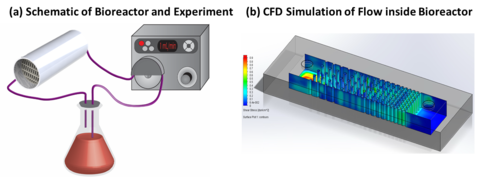Printing of Bioreactors
Designing, Printing, and Modifying the Surface of a Bioreactor
To create an efficient stem cell bioreactor the first step is to use computational design methods to develop a scaffold optimized for fluid flow, cell growth area, and topology. Once a design has been optimized it can be fabricated using an Envisiontec Bioplotter or similar 3D printer. After printing, the surface of the polystyrene structure can be treated with a variety of methods to determine the optimal functionalization that promotes cell adhesion and growth. One of the challenges of 3D printing is the need to modify the chemistry of the polymer surface after printing, as native polymer surfaces do not possess the necessary surface chemistry for cell adhesion, and therefore, growth and differentiation. The chemistry of flat substrates such as polystyrene (PS) can be modified using corona discharge, but the modification of 3D structures is significantly more difficult. Here we utilize plasma-assisted deposition of chemistry to modify the surface. Since plasma takes the form of gas, it can reach into small voids for uniform coverage. Preliminary results on planar polystyrene films indicate that plasma modification is effective at modifying the surface for cell adhesion and growth and efforts are underway to find unique chemistries that can induce differentiation of stem cells.
This project is a collaboration between NIST and Prof. John Fisher at the Tissue Engineering & Biomaterials Laboratory at the University of Maryland.

Related Publications
Lerman, M.J., Lembong, J., Muramoto, S., Gillen, G, and Fisher, J.P. The Evolution of Polystyrene as a Cell Culture Material. Tissue Engineering Part B: Reviews, 2018: 24:5, 359-372
Lerman, M.J., Muramoto, S., Arumugasaamy, N., Van Order, M., Lembong, J., Gerald, A.G., Gillen, G., and Fisher, J.P. Development of Surface Functionalization Strategies for 3D-printed Polystyrene Constructs. J Biomed Mater Res Part B, 2019: 107B: 2566– 2578.
Lerman, M.J., Lembong, J., Gillen, G., and Fisher, J.P. 3D Printing in Cell Culture Systems and Medical Applications. Applied Physics Reviews, 2018: 5: 041109-1 – 041109-12

Contacts
-
(301) 975-5997

